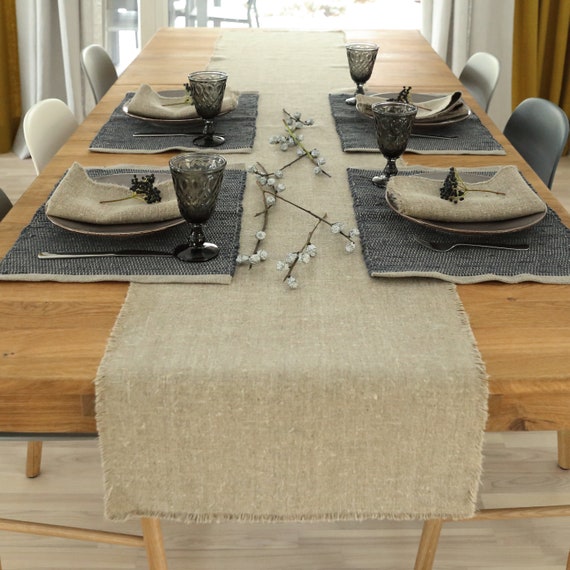Do It Yourself Table Runner Projects: Custom-made Designs for Your Home
Do It Yourself Table Runner Projects: Custom-made Designs for Your Home
Blog Article
Linen Fabric Advancements: Discovering Modern Trends and Creative Applications in Layout and Textile Industry
From lasting manufacturing approaches to cutting-edge weaving modern technologies, the evolution of linen is reshaping the landscape of the fabric sector. As we dig into the realms of creative layout applications and the introduction of linen blends and hybrid textiles, a brand-new phase unfolds in which linen's duty in future fabric advancements takes center phase.
Lasting Practices in Linen Manufacturing
Sustainable practices in bed linen production have become increasingly crucial in the fabric market's initiatives to lessen environmental influence and advertise honest sourcing methods. Bed linen, a natural fiber originated from the flax plant, supplies a series of benefits such as sturdiness, biodegradability, and breathability. Nonetheless, conventional approaches of bed linen manufacturing can entail substantial water intake, pesticide usage, and energy-intensive procedures.
To resolve these challenges, lots of fabric suppliers are adopting lasting practices throughout the linen manufacturing process. This includes sourcing flax from natural ranches that avoid unsafe pesticides and chemicals, carrying out water-efficient retting strategies to extract fibers from the flax stalks, and using environmentally friendly dyes and coatings. Additionally, some companies are spending in eco-friendly energy sources to power their production centers and reducing waste through recycling and upcycling efforts.
Technical Innovations in Linen Weaving
With the growing focus on lasting techniques in bed linen production, the textile market is now experiencing a rise in technological developments particularly targeted at changing the art of linen weaving. These developments are reshaping the method bed linen textiles are generated, providing boosted performance, quality, and creativity in weaving techniques.
One of the key technological advancements in linen weaving is the combination of electronic looms. These sophisticated looms are furnished with software program that enables detailed and intricate designs to be woven with precision. By digitizing the weaving procedure, suppliers can attain better uniformity and precision in their linen materials.
Additionally, improvements in thread spinning modern technology have enabled the manufacturing of finer and even more long lasting linen yarns - table cloths. This causes softer and smoother bed linen materials that keep their high quality even after multiple usages and cleans
Additionally, the growth of eco-friendly dyeing procedures and surfaces for linen textiles is getting traction. These lasting methods not only reduce the ecological effect but additionally accommodate the increasing customer demand for morally generated textiles.
Creative Design Applications for Bed Linen
Innovative artistic strategies are progressively shaping the innovative layout applications for linen in the textile market. Bed linen's all-natural aesthetic charm and capacity to mix with other materials make it a favored choice for creating special garments and devices that provide to the environmentally conscious consumer.
Additionally, developers are try out linen in home decoration, using its breathable and durable nature to craft elegant home furnishings such as drapes, bed linens, and upholstery. he said The structure and drape of bed linen bring a feeling of sophistication and comfort to interior rooms, including a touch of elegance to contemporary homes.

Linen Blends and Hybrid Fabrics

Hybrid textiles, on the other hand, take the concept of mixing a step better by integrating additional components such as metallic strings, recycled products, or conductive fibers. These innovative fabrics not only increase the style opportunities however also present functional facets like conductivity, antimicrobial homes, or enhanced longevity. Crossbreed materials are significantly being used in numerous industries, consisting of style, interior decoration, and technological textiles, where the need for multifunctional materials gets on the rise.
Bed linen's Role in Future Fabric Innovations

In the world of future fabric technologies, linen is expected to be a principal in the growth of advanced practical materials. Scientists and developers are exploring methods to improve bed linen's inherent high qualities with technical improvements, such as including clever fabrics, nanotechnology, and efficiency coatings. These innovations aim to elevate linen's performance attributes, making it suitable for a broader series of applications, from activewear to protective clothing.
Moreover, the combination of bed linen with various other link all-natural or artificial fibers opens limitless possibilities for producing novel textiles with unique residential or commercial properties and performances. By leveraging linen's attributes and exploring innovative blends, the textile sector is positioned to present interesting developments that accommodate advancing customer requirements and sustainability requirements.
Verdict
Finally, the expedition of sustainable techniques, technical improvements, creative design applications, bed linen blends, and its function in future textile technologies highlight the constant evolution of bed linen material in the modern layout and fabric industry. With an emphasis on advancement and creativity, the versatility and green nature of linen make it a valuable product for makers and designers alike, leading the way for more advancements and developments in the area of textiles.
As we dive right into the realms of creative style applications and the emergence of bed linen blends and crossbreed materials, a brand-new chapter unravels in which linen's function in future textile advancements takes facility stage.
Discovering the fusion of bed linen with other materials has actually led to the development of cutting-edge blends and hybrid fabrics in the modern textile sector. Bed linen blends provide an one-of-a-kind combination of the features of linen with those of other fibers, resulting in textiles that possess improved buildings such as enhanced durability, improved draping, and minimized wrinkling.The advancement of linen blends and hybrid textiles has actually set the phase for Linen to play a critical function in driving future fabric innovations.In the realm of future fabric technologies, linen is anticipated to be a key player in the advancement of innovative functional fabrics.
Report this page